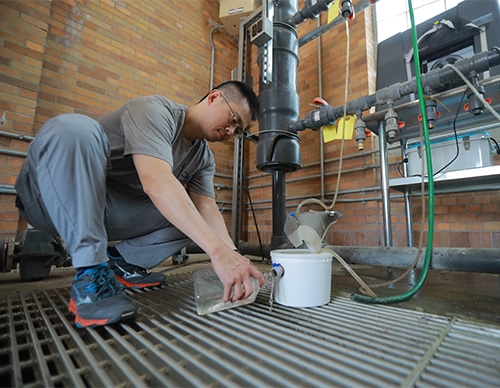Researchers at the University of Toledo are testing a real-time optical sensor at the Toledo Water Treatment Plant as part of its source water monitoring to protect the public drinking water supply during harmful algal bloom season.
The device takes a sip of Lake Erie water coming into the plant every 15 minutes. The device reads the sample and puts the measurement data online for researchers and water utility managers to access remotely.
Its bigger value is the ability to tell whether tiny single-celled organisms known as cyanobacteria that compose harmful algal blooms in Lake Erie are fragile and starting to break open. If the cells break open, they release toxins. The dissolved toxin is more challenging for water treatment plants to remove because it can pass through filters and must be removed by chemical means before water leaves the plant for our faucets.
“Our work, this summer with the PhycoSens device, is the first test of this online algae monitoring system at a drinking water plant in the U.S.,” said Dr. Thomas Bridgeman, professor of ecology and director of the UToledo Lake Erie Center. “If we show success at the Toledo Water Treatment Plant and throughout the region to immediately detect and notify of toxin release, then it can be scaled up nationwide. So far, it’s showing great promise.”

The algae monitoring systems made by the German company bbe Moldaenke use optical sensors to measure in real-time how much and what kind of algae are coming into the water treatment plant, including cyanobacteria. The sensor can provide a warning of the cyanobacteria cells breaking open and leaking their contents, including any toxins that they may contain, into the water.
“A large release of toxin can happen in a matter of hours, and it is critical for water plant operators to have this information so they can adjust their treatment levels quickly before dissolved toxin can get through the plant,” Bridgeman said. “The data are produced every few minutes, which makes it a useful early warning tool for a potentially rapidly changing algal situation.”
“So far, we have not detected any of that cell breakage at the water treatment plant or near the water intake out in the lake using the automated sensor, which is good news,” Bridgeman said. “However, UToledo crews on our research vessel taking water samples out in the lake throughout Lake Erie’s western basin – not near the water intake – have detected cell breakage using the manual version of the same device this season.”
The Toledo Water Treatment Plant’s laboratory makes the most use of the data. “The experimental optical sensors being tested at the raw water pump station are a useful source for both the changes and the severity of algae levels coming from the lake,” said Jeff Martin, chief chemist at the Toledo Water Treatment Plant. “We didn’t have remote access to the data until part of the way through the bloom season due to computer issues, but since then, it has been a welcome tool in treatment decisions.”
The algae sensor will be removed from the water treatment plant for analysis in October, and then Bridgeman and his team will study the results and potentially put it back in the plant next summer. Bridgeman’s device monitoring tests are one part of a larger, wide-ranging project funded by the U.S. Army Corps of Engineers that also includes faculty in the UToledo College of Engineering.
Dr. Youngwoo Seo, professor of civil and environmental engineering and chemical engineering, leads the three-year project to improve water quality from the source to the tap. He is focused on mitigation and the treatment method for toxin removal. His laboratory is working on the biological degradation of cyanobacteria and their toxins using naturally occurring bacteria and viruses from the lake and NSF-approved chemical treatments.
Researchers test advanced, real-time algae sensor at water treatment plant
Source: Tambay News

0 Comments